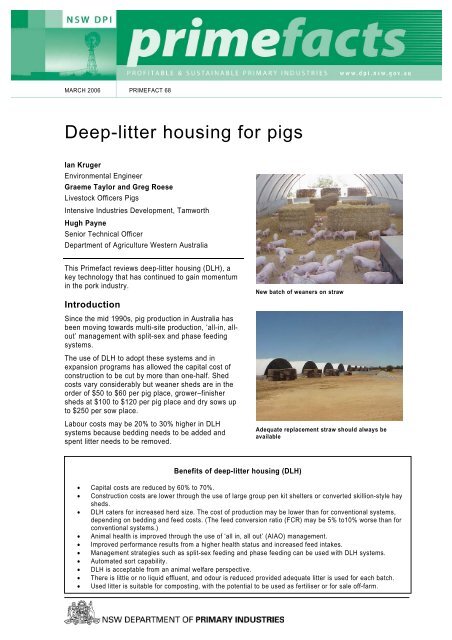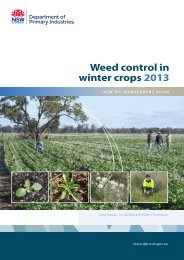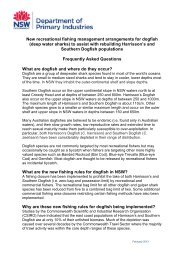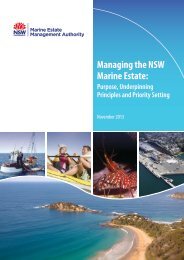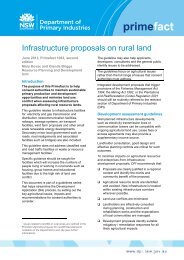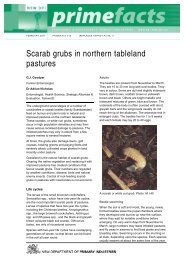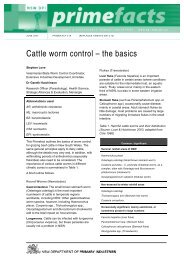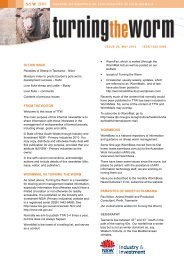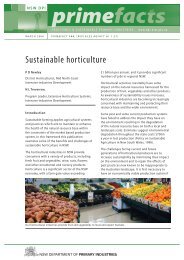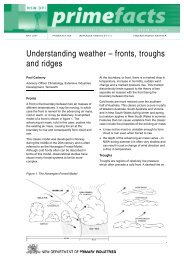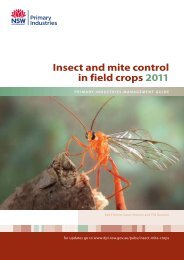Deep-litter housing for pigs - NSW Department of Primary Industries
Deep-litter housing for pigs - NSW Department of Primary Industries
Deep-litter housing for pigs - NSW Department of Primary Industries
Create successful ePaper yourself
Turn your PDF publications into a flip-book with our unique Google optimized e-Paper software.
MARCH 2006 PRIMEFACT 68<br />
<strong>Deep</strong>-<strong>litter</strong> <strong>housing</strong> <strong>for</strong> <strong>pigs</strong><br />
Ian Kruger<br />
Environmental Engineer<br />
Graeme Taylor and Greg Roese<br />
Livestock Officers Pigs<br />
Intensive <strong>Industries</strong> Development, Tamworth<br />
Hugh Payne<br />
Senior Technical Officer<br />
<strong>Department</strong> <strong>of</strong> Agriculture Western Australia<br />
This Primefact reviews deep-<strong>litter</strong> <strong>housing</strong> (DLH), a<br />
key technology that has continued to gain momentum<br />
in the pork industry.<br />
Introduction<br />
New batch <strong>of</strong> weaners on straw<br />
Since the mid 1990s, pig production in Australia has<br />
been moving towards multi-site production, ‘all-in, allout’<br />
management with split-sex and phase feeding<br />
systems.<br />
The use <strong>of</strong> DLH to adopt these systems and in<br />
expansion programs has allowed the capital cost <strong>of</strong><br />
construction to be cut by more than one-half. Shed<br />
costs vary considerably but weaner sheds are in the<br />
order <strong>of</strong> $50 to $60 per pig place, grower–finisher<br />
sheds at $100 to $120 per pig place and dry sows up<br />
to $250 per sow place.<br />
Labour costs may be 20% to 30% higher in DLH<br />
systems because bedding needs to be added and<br />
spent <strong>litter</strong> needs to be removed.<br />
Adequate replacement straw should always be<br />
available<br />
Benefits <strong>of</strong> deep-<strong>litter</strong> <strong>housing</strong> (DLH)<br />
• Capital costs are reduced by 60% to 70%.<br />
• Construction costs are lower through the use <strong>of</strong> large group pen kit shelters or converted skillion-style hay<br />
sheds.<br />
• DLH caters <strong>for</strong> increased herd size. The cost <strong>of</strong> production may be lower than <strong>for</strong> conventional systems,<br />
depending on bedding and feed costs. (The feed conversion ratio (FCR) may be 5% to10% worse than <strong>for</strong><br />
conventional systems.)<br />
• Animal health is improved through the use <strong>of</strong> ‘all in, all out’ (AIAO) management.<br />
• Improved per<strong>for</strong>mance results from a higher health status and increased feed intakes.<br />
• Management strategies such as split-sex feeding and phase feeding can be used with DLH systems.<br />
• Automated sort capability.<br />
• DLH is acceptable from an animal welfare perspective.<br />
• There is little or no liquid effluent, and odour is reduced provided adequate <strong>litter</strong> is used <strong>for</strong> each batch.<br />
• Used <strong>litter</strong> is suitable <strong>for</strong> composting, with the potential to be used as fertiliser or <strong>for</strong> sale <strong>of</strong>f-farm.
Table 1. <strong>Deep</strong>-<strong>litter</strong> <strong>housing</strong> checklist <strong>for</strong> building features<br />
Building feature<br />
Check<br />
()<br />
Building feature<br />
Check<br />
()<br />
Site<br />
Spray cooling<br />
Elevated site with free-draining soils<br />
Automatic control, fine sprays preferable<br />
Flood-free<br />
Adjust to cool <strong>pigs</strong> without overwetting <strong>litter</strong><br />
All-weather vehicle access<br />
Space allowance<br />
Drainage away from sheds<br />
Weaners to 10 weeks/35 kg = 0.55 m 2 /pig<br />
No barriers to natural ventilation<br />
Growers to 20 weeks = 1 m 2 /pig<br />
Adequate sealed storage area <strong>for</strong> used <strong>litter</strong><br />
Finishers to 24 weeks/110 kg = 1.15 m 2 /pig<br />
Earthworks completed prior to construction<br />
Dry sows (bedded area) = 2.5–3.5 m 2 /pig<br />
Building orientation<br />
Bedding material<br />
Long axis, east–west where possible<br />
Barley straw preferable<br />
Building construction<br />
Wheat, oat and triticale straw<br />
Coverings with 95% to 98% UV protection<br />
Maize stalks, canola residues<br />
Shade may be necessary at shed ends<br />
Sawdust<br />
Slope mono-pitch ro<strong>of</strong>s north to south<br />
Rice hulls<br />
Provide 1 to 1.2 metre wide eaves on north side<br />
Bedding quantity (guide only)<br />
Galvanised frame<br />
Supply sufficient <strong>for</strong> thermal com<strong>for</strong>t<br />
Sidewall blinds and shutters<br />
Barley straw – weaners = 0.3–0.4 kg/pig/day<br />
Endwall: louvres, blinds or fixed<br />
Barley straw – growers/finishers = 0.6–0.8 kg/pig/day<br />
Shed supplied in kit or components<br />
Barley straw – dry sows = 1.8 kg/pig/day<br />
Material transport costs<br />
Wheat straw – growers/finishers = 0.8 kg/pig/day<br />
Separation distance<br />
Oat straw – growers/finishers = 0.6 kg/pig/day<br />
Shed spacing end to end, side to side = 5 x height<br />
Maize stalks – growers/finishers = 0.8 kg/pig/day<br />
Vehicle access <strong>for</strong> stock loading and cleaning<br />
Hrdwd sawdust – growers/finishers = 1.2 kg/pig/day<br />
Pad and floor<br />
Pine sawdust – growers/finishers = 0.7 kg/pig/day<br />
Elevate pad 100 to 300 mm<br />
Pine shavings – growers/finishers = 0.9 kg/pig/day<br />
Compacted earth floor (impervious)<br />
Bedding management<br />
Concrete floor (preferable)<br />
Aim <strong>for</strong> 40% floor to be clean and dry<br />
Feeders<br />
Add and spread bedding as required<br />
Automatic feed delivery preferable<br />
Shed management<br />
Large range, e.g. tunnel, conventional etc.<br />
‘All in, all out’ with pig age range within 1 week<br />
Wet/dry feeders<br />
Health<br />
Drinkers<br />
Daily inspection <strong>of</strong> <strong>pigs</strong><br />
Bowl, cup, pan preferred (avoid spillage)<br />
Separate sick <strong>pigs</strong><br />
Proved 3.0 to 3.5 L/kg feed intake<br />
Market<br />
Water medication<br />
Aim <strong>for</strong> minimal weight variation between <strong>pigs</strong><br />
Proportioners / header tanks<br />
Sort <strong>pigs</strong> to achieve max. prime grade<br />
Savings can be made by running large groups and<br />
by using automatic sorter systems. Sorters also<br />
increase the number <strong>of</strong> <strong>pigs</strong> marketed in the prime<br />
weight range.<br />
Construction sites<br />
Table 1 highlights many <strong>of</strong> the aspects <strong>for</strong><br />
consideration when planning and building a deep<br />
<strong>litter</strong> <strong>housing</strong> system.<br />
<strong>Deep</strong>-<strong>litter</strong> <strong>housing</strong> <strong>for</strong> <strong>pigs</strong> | Primefact 68 2
Locate buildings with consideration to soil type,<br />
drainage, wind and temperature. Construction <strong>of</strong><br />
shed bases and drainage around sheds are <strong>of</strong><br />
paramount importance.<br />
Construction <strong>of</strong> shed bases<br />
Shed bases include uncompacted earthen floors,<br />
compacted earthen/aggregate floors and concrete<br />
floors.<br />
Uncompacted earthen floors are no longer<br />
permitted by regulatory authorities in <strong>NSW</strong>.<br />
Raised, compacted earthen floors are the<br />
minimum requirement <strong>for</strong> deep <strong>litter</strong> systems. The<br />
maximum permeability required is 1 × 0 –9 m/s,<br />
which is equivalent to 0.1 mm/day seepage. For<br />
earth pad construction, refer to the Queensland<br />
<strong>Department</strong> <strong>of</strong> <strong>Primary</strong> <strong>Industries</strong> & Fisheries<br />
(QDPI&F) Note titled Earth pad preparation<br />
requirements <strong>for</strong> deep <strong>litter</strong> pig production systems<br />
and solid waste stockpile and composting areas,<br />
which is available on their website at:<br />
http://www.dpi.qld.gov.au.<br />
After years <strong>of</strong> use, compacted earth floors may<br />
break down and require ongoing maintenance due<br />
to constant wetting and removal <strong>of</strong> earth with <strong>litter</strong>.<br />
Concrete floors are the best option <strong>for</strong><br />
guaranteeing no seepage, minimising<br />
maintenance requirements and easier <strong>litter</strong><br />
removal. Sheds can be easily disinfected between<br />
batches, which is an important hygiene<br />
consideration. Also, concrete will eliminate the<br />
potential <strong>for</strong> the leaching <strong>of</strong> nutrients and<br />
pathogens into the soil pr<strong>of</strong>ile beneath the sheds<br />
and into groundwater.<br />
Controlled drainage around sheds<br />
Raised shed bases prevent overland water running<br />
into the sheds. This also minimises the potential<br />
<strong>for</strong> nutrients and pathogens to run <strong>of</strong>f to surface<br />
water (creeks, rivers, dams) and then leaching to<br />
groundwater.<br />
Contain all run-<strong>of</strong>fs from shed ro<strong>of</strong>s and<br />
surrounding areas into a controlled drainage area.<br />
This includes run-<strong>of</strong>f from shed leachate, spent<br />
<strong>litter</strong> and manure storage areas and carcasscomposting<br />
areas. The aim is to prevent<br />
contaminated water from escaping to surrounding<br />
land, streams, freshwater dams, neighbouring<br />
properties and native vegetation areas. Bunding<br />
(earth diversion banks) can be built around the<br />
facility and a catch dam built to collect<br />
contaminated water <strong>for</strong> reuse if necessary.<br />
Avoid any ponding <strong>of</strong> contaminated water around<br />
sheds and facilities to prevent saturation areas<br />
which could leach contaminants to groundwater.<br />
Other considerations<br />
When locating a new facility, consider access to<br />
water and power supplies. Also, it is important to<br />
have all-weather access <strong>for</strong> feed and stock trucks.<br />
Depending on local wind and climate<br />
characteristics, shelters are normally oriented<br />
lengthwise along an east–west axis. Side and end<br />
blinds are used to maximise ventilation during hot<br />
periods.<br />
Construction <strong>of</strong> sheds will normally require<br />
approval from the local council. Depending on the<br />
proposed size, a development application or<br />
environmental impact assessment may be<br />
required. Further in<strong>for</strong>mation can be found on the<br />
Australian Pork Limited (APL) website<br />
www.australianpork.com.au/ and click on ‘Issues<br />
Watch’ <strong>for</strong> environmental requirements.<br />
Internal shed fittings<br />
Design internal fittings <strong>for</strong> deep <strong>litter</strong> <strong>housing</strong><br />
systems to minimise production costs and to keep<br />
shelters as clean and dry as possible. Feeders<br />
and drinkers are commonly mounted on a raised<br />
concrete pad running the length or width <strong>of</strong> the<br />
shed. This assists with keeping the feeding area<br />
clean and it reduces <strong>litter</strong> requirements.<br />
Feeders consist generally <strong>of</strong> wet and dry<br />
competition feeders which feed up to 35 <strong>pigs</strong> per<br />
feeder, or multiple-space dry feeders with drinkers<br />
nearby. These are designed to feed large groups<br />
<strong>of</strong> <strong>pigs</strong> while minimising feed wastage.<br />
Install drinkers that minimise water wastage and<br />
spillage. Bowl-type drinkers are commonly used.<br />
Adjustable height drinkers may be required if<br />
<strong>pigs</strong> are kept in shelters <strong>for</strong> several growth<br />
phases.<br />
In many areas spray cooling will be required to<br />
optimise summer growth. Generally, if<br />
conventional sheds require spray cooling, it will<br />
also be necessary <strong>for</strong> deep-<strong>litter</strong> <strong>housing</strong>. Pigs in<br />
hot weather conditions where there is no spray<br />
cooling provided, will <strong>of</strong>ten create wallows under<br />
drinkers or dung on feed pads. Spray cooling<br />
above rest areas provides cooling and will<br />
minimise undesirable dunging patterns. However,<br />
it is important to manage the timing <strong>of</strong> spray<br />
cooling in order to avoid wet <strong>litter</strong>.<br />
Shelters located away from mains power have<br />
successfully used solar-powered 12 volt systems<br />
to produce enough electricity to run a water pump<br />
<strong>for</strong> spray cooling.<br />
<strong>Deep</strong>-<strong>litter</strong> <strong>housing</strong> <strong>for</strong> <strong>pigs</strong> | Primefact 68 3
Growers on straw<br />
Swing drinkers increase the likelihood <strong>of</strong> wet patches.<br />
Supplementary heating in shelters is not usually<br />
required as the <strong>litter</strong> maintains a favourable<br />
temperature range. For newly weaned <strong>pigs</strong>, straw<br />
bales can be stacked to <strong>for</strong>m protected creep<br />
areas within shelters. After several weeks, the<br />
bales can be spread out as extra bedding.<br />
Some producers provide hinged kennel ro<strong>of</strong>s that<br />
can be raised when not required.<br />
Auto-weighers or sorters can be equipped with<br />
automatic spray markers. Pigs that are<br />
underweight can be identified <strong>for</strong> retention until the<br />
next market load.<br />
A continuous sort (see Fig. 6 on page 9) occurs on<br />
an ongoing basis and allows sorting <strong>of</strong> <strong>pigs</strong> <strong>for</strong><br />
market, health or different feeding regimens.<br />
Stocking rate and movement<br />
See Table 1 <strong>for</strong> space allowance requirements <strong>for</strong><br />
each class <strong>of</strong> stock.<br />
When moving stock, use boards, inflated rollers,<br />
curtains and backing fences to help minimise<br />
stress in <strong>pigs</strong>. Also, <strong>for</strong> safety it is important to<br />
have two staff on hand when moving large<br />
numbers <strong>of</strong> stock.<br />
Weaners, growers and finishers<br />
Many producers report improved weaner<br />
per<strong>for</strong>mance when <strong>pigs</strong> are grown on deep <strong>litter</strong><br />
compared with conventional <strong>housing</strong>. The main<br />
benefit is the disease break achieved by using an<br />
‘all in, all out’ management system. Improvements<br />
in weaner health increase growth rates and<br />
improve feed conversion. Litter also provides an<br />
ideal insulating material <strong>for</strong> warmth, which helps<br />
minimise post-weaning growth depression.<br />
Weaners are <strong>of</strong>ten introduced to deep <strong>litter</strong><br />
systems at an entry point closest to the feeders.<br />
This will reduce the time taken <strong>for</strong> their first feed in<br />
their new accommodation.<br />
Weaners can be moved into shelters at 3–4 weeks<br />
<strong>of</strong> age and can remain <strong>for</strong> 4–6 weeks be<strong>for</strong>e<br />
returning to conventional <strong>housing</strong>. Alternatively,<br />
Bowl drinkers minimise spillage.<br />
Drinking trough <strong>for</strong> dry sows<br />
weaners can be moved into shelters and remain<br />
until they have reached market weight.<br />
When growers remain in deep-<strong>litter</strong> systems until<br />
they are ready to be sent to market, variation in<br />
weights and backfat thickness will have to be<br />
managed carefully. For more in<strong>for</strong>mation on<br />
market weight variability refer to the Primefact 65<br />
Market weight variation in the pork industry (see<br />
www.agric.nsw.gov.au/reader/<strong>pigs</strong>).<br />
If growers are moved back into conventional<br />
<strong>housing</strong> at about 60 kg, greater control can be<br />
gained over feed intakes, and gilt selection can be<br />
easily managed. However, moving <strong>pigs</strong> back into<br />
sheds increases labour requirements and some<br />
benefits <strong>of</strong> ‘all in, all out’ management systems are<br />
lost.<br />
<strong>Deep</strong>-<strong>litter</strong> <strong>housing</strong> <strong>for</strong> <strong>pigs</strong> | Primefact 68 4
<strong>Deep</strong> <strong>litter</strong> shed cleaned out and limed prior to next<br />
batch<br />
Dry sows on rice hulls<br />
Weaners on sawdust<br />
Dry sows on straw<br />
an increase in aggression among recently grouped<br />
unfamiliar gilts and sows.<br />
Weaners on straw with kennels<br />
Dry sows<br />
It would be unwise <strong>for</strong> Australian pig producers to<br />
invest in new sow accommodation without<br />
considering the possible effects <strong>of</strong> future<br />
legislation. Refer to the Australian Pork website at<br />
www.australianpork.com.au/ and click on ‘Issues<br />
watch’ <strong>for</strong> more in<strong>for</strong>mation on animal health and<br />
welfare.<br />
Housing sows on deep <strong>litter</strong> has become a viable<br />
alternative to conventional systems based on<br />
stalls. <strong>Deep</strong>-<strong>litter</strong> systems are welfare-friendly and<br />
construction and maintenance are cheaper than<br />
<strong>for</strong> conventional systems.<br />
The advantages <strong>of</strong> <strong>litter</strong>-based shelters <strong>for</strong> groups<br />
<strong>of</strong> sows include:<br />
• less aggression between sows;<br />
• reduced leg problems and stillbirths;<br />
• the benefits <strong>of</strong> batch farrowing, if required.<br />
Group <strong>housing</strong> sows and gilts during gestation<br />
reduces or eliminates adverse behaviour <strong>of</strong>ten<br />
associated with sow stalls. However, there may be<br />
Litter size and farrowing rate are lower when sows<br />
are mixed during the first week after mating<br />
compared to 28 days after mating. This is due to<br />
higher levels <strong>of</strong> aggression when first introduced<br />
to the group. Suggestions to reduce the likelihood<br />
<strong>of</strong> aggression include the following:<br />
• Provide escape areas.<br />
• Group after dark.<br />
• Provide ad lib feed during grouping period.<br />
Sows housed in groups should be fed in a way<br />
that minimises competition <strong>for</strong> feed while<br />
managing individual sow feeding requirements.<br />
Methods include the use <strong>of</strong> floor, stall and<br />
electronic feeders and self-feeders.<br />
An area <strong>of</strong> 2.5 m 2 /sow is suggested if individual<br />
stalls are provided and up to 3.5 m 2 /sow if floor<br />
feeding is practised.<br />
A shed divided into two groups with a stalled<br />
feeding area in the middle (Fig. 5 on page 9) has<br />
several advantages. Sows have equal access to<br />
food, they can be more easily identified and<br />
overall sow management is improved. As only half<br />
the sows are being fed at any one time, the<br />
concrete feeding area and numbers <strong>of</strong> feed stalls<br />
are halved. Sows quickly learn the daily routine<br />
and wait their turn to be fed.<br />
The estimated amount <strong>of</strong> bedding material<br />
required <strong>for</strong> gestation sows housed in a group<br />
varies from about 270 kg/sow to 760 kg/sow. The<br />
wide range is due to differences in absorbency <strong>of</strong><br />
<strong>Deep</strong>-<strong>litter</strong> <strong>housing</strong> <strong>for</strong> <strong>pigs</strong> | Primefact 68 5
the products used and the different climatic<br />
conditions. Barley is <strong>of</strong>ten the preferred option due<br />
to its high absorbency and is included at a rate <strong>of</strong><br />
360–540 kg/sow.<br />
Health and welfare<br />
Daily health checks in deep-<strong>litter</strong> systems are<br />
essential. When checking sheds, move down the<br />
shed in a zig-zag pattern ensuring that all <strong>pigs</strong><br />
move around. Also check that all feeders and<br />
drinkers are operational.<br />
Providing adequate space and feeding points will<br />
minimise injury, regardless <strong>of</strong> group size. This is<br />
advantageous because productivity is directly<br />
related to animal wellbeing.<br />
Refer to the Australian Pork Limited website at<br />
www.australianpork.com.au and click on ‘Issues<br />
Watch’ <strong>for</strong> more in<strong>for</strong>mation on animal health and<br />
welfare.<br />
Contract growing<br />
Contract growing <strong>pigs</strong> <strong>of</strong>fers the benefits <strong>of</strong> a<br />
regular cash flow, without investing heavily in<br />
<strong>housing</strong> or breeding sows. The supplier retains<br />
ownership <strong>of</strong> the <strong>pigs</strong>. Typically, contractors are<br />
paid a fixed rate per pig sold <strong>for</strong> their labour and<br />
management. Bonuses or penalties are applied <strong>for</strong><br />
feed efficiency and carcase quality. Be<strong>for</strong>e<br />
entering into a contract it is recommended that you<br />
seek legal advice.<br />
<strong>Deep</strong> <strong>litter</strong> contract costs are in the range 75c to<br />
80c/pig/week. If <strong>litter</strong> is not provided at<br />
recommended rates, it can result in an increase in<br />
shed wet areas, reduced growth rates and<br />
increasing health and welfare problems.<br />
Contractors can aim to recover establishment or<br />
capital costs in less than 3 years. The construction<br />
cost <strong>for</strong> deep-<strong>litter</strong> systems is about $120 per pig<br />
place, which equates to about 77c/pig/week to<br />
cover capital costs.<br />
Litter costs vary considerably. In northern <strong>NSW</strong><br />
sawdust can be purchased <strong>for</strong> $25 to $30 per<br />
tonne. In most <strong>of</strong> <strong>NSW</strong>, cereal straw can be<br />
purchased <strong>for</strong> $80 to $100 per tonne, and in<br />
southern <strong>NSW</strong> rice hulls cost about $35 per tonne.<br />
At the recommended <strong>litter</strong> rate <strong>of</strong> about<br />
5 kg/pig/week, <strong>litter</strong> costs may vary from 15c to<br />
40c/pig/week.<br />
Contract growers operating under a set contract<br />
rate will generally not add more <strong>litter</strong> to achieve<br />
better per<strong>for</strong>mance <strong>for</strong> the breeder. Purchasing<br />
the extra <strong>litter</strong> will reduce the contractor’s personal<br />
income or viability. Also, in drought years there<br />
has been an attempt by contractors to use less<br />
<strong>litter</strong> because <strong>of</strong> higher costs. They maintain their<br />
pr<strong>of</strong>itability at the expense <strong>of</strong> pig per<strong>for</strong>mance <strong>for</strong><br />
the breeder.<br />
It is advisable to include <strong>litter</strong> quantities and the<br />
cost in the contractual arrangement with the<br />
breeder or supplier.<br />
Litter use<br />
Cheap <strong>litter</strong> is an essential requirement <strong>for</strong><br />
successful and pr<strong>of</strong>itable management <strong>of</strong> deep<strong>litter</strong><br />
<strong>housing</strong> systems. Baled cereal stubble is<br />
most commonly used but rice hulls and sawdust<br />
have also been successful. The amount <strong>of</strong> straw<br />
used varies depending on climate, pig age,<br />
penning arrangement, type <strong>of</strong> <strong>litter</strong> and other<br />
management factors. The quantity can range from<br />
0.3 kg/pig/day to 1.8 kg/pig/day (Table 1).<br />
Large bales are easily moved with a tractor and<br />
bale handler. Spent straw is normally cleaned out<br />
<strong>of</strong> shelters using a front-end loader or bobcat.<br />
If rice hulls are used the total volume required <strong>for</strong><br />
the life <strong>of</strong> a batch <strong>of</strong> <strong>pigs</strong> can be added at the start<br />
<strong>of</strong> the batch. Also, rice hulls are easily worked<br />
over by the <strong>pigs</strong>, resulting in good aeration. Straw,<br />
however, generally <strong>for</strong>ms layers and requires<br />
topping up on a regular basis. Hence labour costs<br />
when using straw can be higher than when using<br />
rice hulls.<br />
A guide <strong>for</strong> bedding requirements is about<br />
50 kg/grower and 15 kg/weaner/batch. All manure<br />
and urine is absorbed into the bedding during the<br />
batch.<br />
DLH has the added advantage that about 200 kg<br />
<strong>of</strong> wet <strong>litter</strong> is produced per pig during the growing<br />
and finishing phase <strong>of</strong> production. Spent <strong>litter</strong> has<br />
a high fertiliser value.<br />
Addition <strong>of</strong> <strong>litter</strong> to sheds<br />
Well-managed deep-<strong>litter</strong> sheds emit about half<br />
the odour <strong>of</strong> conventional sheds that have a<br />
flushing system. There<strong>for</strong>e, deep-<strong>litter</strong> systems<br />
can have reduced odour-separation distances to<br />
neighbours. However, odour emissions will greatly<br />
increase if <strong>litter</strong> is allowed to get too wet and<br />
decompose anaerobically. This can result in an<br />
increase in pig health problems, poor growth rates<br />
and reduced overall welfare.<br />
It is important to use fresh <strong>litter</strong> <strong>for</strong> each batch <strong>of</strong><br />
<strong>pigs</strong> to minimise any health risk and to add<br />
sufficient bedding to sheds at the start <strong>of</strong> a batch<br />
in order to absorb manure, spilt feed and water.<br />
The <strong>pigs</strong>’ lying areas should be kept dry and any<br />
defined dunging areas should be prevented from<br />
becoming too wet. Regular addition <strong>of</strong> fresh <strong>litter</strong>,<br />
particularly towards the end <strong>of</strong> the batch cycle,<br />
may be needed to avoid excessive moisturerelated<br />
problems. Forty per cent <strong>of</strong> the shed floor<br />
area should be maintained as dry lying area <strong>for</strong><br />
<strong>pigs</strong> until the end <strong>of</strong> the batch.<br />
Shed <strong>litter</strong> quality can be gauged by the level <strong>of</strong><br />
visible moisture. There should be no free moisture<br />
visible in the <strong>litter</strong> and no puddles, pools or<br />
<strong>Deep</strong>-<strong>litter</strong> <strong>housing</strong> <strong>for</strong> <strong>pigs</strong> | Primefact 68 6
wallows. Also, there should be few excessively<br />
dirty or wet <strong>pigs</strong>.<br />
Problems are <strong>of</strong>ten worse in winter when less<br />
evaporation occurs from the <strong>litter</strong>. These are<br />
exaggerated when floor space per pig is<br />
compromised. Producers <strong>of</strong>ten design sheds that<br />
have inadequate floor space to cater <strong>for</strong> required<br />
pig market weights. Producers also <strong>of</strong>ten add too<br />
many <strong>pigs</strong> due to variations in production flow.<br />
Skimping on bedding may cost more in the long<br />
term through lost production efficiency. Poor<br />
management will cause production, health and<br />
welfare concerns.<br />
In the future, more producers will purchase or<br />
develop machinery to blow <strong>litter</strong> into shed wet<br />
areas.<br />
Storage and treatment <strong>of</strong> spent <strong>litter</strong> and<br />
composted carcass<br />
Construct storage and treatment areas to prevent<br />
ingress <strong>of</strong> overland run-<strong>of</strong>f and the escape <strong>of</strong><br />
manure in the run-<strong>of</strong>f. This can be achieved by<br />
constructing raised pads or an earth wall bunding<br />
and containment, preferably in the controlled<br />
drainage area. These areas need to have a<br />
compacted base to prevent seepage <strong>of</strong> manure<br />
leachate through the soil to groundwater (less than<br />
0.1 mm/day).<br />
Contain all spent manure, <strong>litter</strong>, <strong>litter</strong> composting<br />
and carcass composting in sealed and bunded<br />
areas to prevent pollutant escape. This will avoid<br />
run-<strong>of</strong>f <strong>of</strong> nutrients and pathogens to surface water<br />
(creeks, rivers, dams) and leaching to<br />
groundwater.<br />
Composting spent <strong>litter</strong> will minimise odour<br />
problems.<br />
Sustainable spreading and reuse <strong>of</strong><br />
spent <strong>litter</strong><br />
Spreading spent <strong>litter</strong> can cause an odour<br />
nuisance to neighbours. There is also the potential<br />
<strong>for</strong> nutrient and pathogen pollution <strong>of</strong> soils, surface<br />
water and groundwater from unsustainable, that is,<br />
high application rates and from spreading near<br />
waterways.<br />
Do not spread spent <strong>litter</strong> close to neighbours and<br />
only spread it when the wind is blowing away from<br />
them. Do not spread spent <strong>litter</strong> within 20 m <strong>of</strong> any<br />
intermittent watercourses and not within 50 m <strong>of</strong><br />
major streams or rivers. A grassed buffer strip<br />
between cropping areas and waterways will<br />
protect them from manure and nutrient run-<strong>of</strong>f.<br />
Spreading manure and <strong>litter</strong> on cut-and-cart crops<br />
(grains or hay) removes eight to ten times more <strong>of</strong><br />
the applied nutrients compared with a grazed<br />
pasture.<br />
Spreading manure and <strong>litter</strong> at more than 5–8 t/ha<br />
every year or 15–25 t/ha every 3 years is likely to<br />
overload soils with nutrients. This will also<br />
For environmentally friendly deep-<strong>litter</strong> systems:<br />
• Keep <strong>litter</strong> and manure as dry as possible so it<br />
doesn’t cause odour or pig problems.<br />
• Seal bases <strong>of</strong> sheds and storage areas so they<br />
don’t seep or leach pollutants.<br />
• Bund and drain all facilities so run-<strong>of</strong>f or leakage<br />
won’t carry pollutants away.<br />
• Measure and calculate manure/<strong>litter</strong> quantities<br />
and application rates and grow cut-and-cart<br />
crops to sustainably and economically use it.<br />
increase the possibility <strong>of</strong> pollution <strong>of</strong> surface or<br />
groundwater in wet seasons. A guide to equivalent<br />
fertiliser rates <strong>for</strong> used <strong>litter</strong> is as follows:<br />
30% <strong>of</strong> nitrogen in 15 t/ha is available in the first<br />
year, which equates to 100 kg <strong>of</strong> urea.<br />
To prove sustainable reuse, it is necessary to<br />
keep records <strong>of</strong>:<br />
• quantity <strong>of</strong> manure and <strong>litter</strong> spread each year;<br />
• laboratory nutrient analyses or good nutrient<br />
estimates <strong>of</strong> the <strong>litter</strong> nutrients to be spread;<br />
• estimated quantity <strong>of</strong> nutrient to be spread or<br />
sold each year from the system;<br />
• crops to be grown and nutrient uptake in the<br />
crop;<br />
• land area estimates based on the majority <strong>of</strong><br />
spread nitrogen and phosphorus, allowing <strong>for</strong><br />
nitrogen volatilisation losses during spreading<br />
and allowable phosphorus sorption in the soil<br />
type used.<br />
Table 2 shows a theoretical estimate <strong>of</strong> nutrients<br />
available in spent <strong>litter</strong> and manure from 1000<br />
grower <strong>pigs</strong> (1000 SPU) on barley straw deep<br />
<strong>litter</strong>. This is calculated from QDPI&F Piggery<br />
Assessment Spreadsheet, Version 10C, June<br />
2004.<br />
If this is applied to a cereal crop yielding 4 t/ha,<br />
which removes 80 kg N/ha and 12 kg P/ha, then<br />
approximately 100 ha <strong>of</strong> crop needs to be grown<br />
annually to remove the above nutrients in the<br />
harvested grain. The spreading rate will be 576<br />
tonnes divided by 100.<br />
Spread manure and <strong>litter</strong> as evenly as possible at<br />
the calibrated rate suited to the specific crop and<br />
expected yield.<br />
Dropping manure heaps on small areas <strong>of</strong> ground<br />
and spreading them with a tractor blade to coat<br />
the ground with a thick layer <strong>of</strong> manure is an<br />
unsustainable practice. This will apply nutrients at<br />
vastly greater rates than crop requirements, in fact<br />
more than a hundredfold. There is enormous<br />
potential to pollute surface water in run-<strong>of</strong>f, and<br />
groundwater through leaching <strong>of</strong> nutrients.<br />
<strong>Deep</strong>-<strong>litter</strong> <strong>housing</strong> <strong>for</strong> <strong>pigs</strong> | Primefact 68 7
Table 2. Mass balance <strong>for</strong> 1000 grower pig deep-<strong>litter</strong> system.<br />
Nutrients (kg/year)<br />
Activity Total solids Nitrogen Phosphorus Potassium<br />
Bedding added (DM) 266,500 2,000 200 6,900<br />
Manure added (DM) 110,000 9,000 3,000 2,500<br />
Shed losses (DM) 56,500 1,100 0 0<br />
Out <strong>of</strong> shed (DM) 320,000 9,900 3,200 9,400<br />
Stockpile losses (DM) 32,000 1,000 0 0<br />
Land applied (DM) 288,000 8,900 3,200 9,400<br />
Land applied (wet) 1 576,000<br />
Land applied wet solid % 1.6% 0.6% 1.6%<br />
Equiv. fertiliser value $8,400 2 $10,600 2 $8,600 2<br />
Total fertiliser value $27,600 2<br />
Notes:<br />
1<br />
Wet solids @ 50% moisture content.<br />
2<br />
Fertiliser values used: urea $430/t; superphosphate $290/t; muruiate <strong>of</strong> potash $460/t.<br />
Some producers compost spent <strong>litter</strong> to eliminate<br />
weed seed contamination and to provide an<br />
improved fertiliser product <strong>for</strong> <strong>of</strong>f-farm sale.<br />
Agronomic value <strong>of</strong> deep <strong>litter</strong><br />
Pig shed deep <strong>litter</strong> is best applied to high value<br />
crops such as canola. It would also be valuable to<br />
spread <strong>litter</strong> on cereal and legume crops.<br />
Spent <strong>litter</strong> is a valuable resource at $27,600 per<br />
1000 SPU per year (see Table 2).<br />
If in doubt about the suitability <strong>of</strong> spreading spent<br />
<strong>litter</strong> on any specific crop, obtain a nutrient<br />
analysis <strong>of</strong> the <strong>litter</strong> and consult an agronomist<br />
prior to application.<br />
Concluding comments<br />
Although deep-<strong>litter</strong> <strong>housing</strong> has been widely<br />
adopted, the recent drought caused the price <strong>of</strong><br />
straw and feed to increase significantly. The high<br />
cost <strong>of</strong> feed in association with higher feed<br />
conversion ratios experienced in shelters has<br />
increased the cost <strong>of</strong> production in shelters,<br />
making them less attractive. Additionally, some <strong>of</strong><br />
the early shelters were built with inexpensive<br />
materials and these now require considerable<br />
maintenance. The logistics <strong>of</strong> handling large<br />
quantities <strong>of</strong> straw and manure has also caused<br />
some producers to question the long-term viability<br />
<strong>of</strong> shelters.<br />
Interest rates are now much lower than they were<br />
ten years ago when many producers made<br />
decisions to build shelters rather than<br />
conventional buildings. This may make it easier to<br />
borrow and service the additional capital required<br />
<strong>for</strong> conventional buildings.<br />
However, many smaller producers have neither<br />
the capacity to borrow the capital required nor<br />
confidence in the long-term future <strong>of</strong> the pig<br />
industry to invest in conventional buildings that<br />
must be depreciated over a longer period; instead,<br />
smaller producers prefer the low-cost option <strong>of</strong><br />
shelters.<br />
Published by <strong>NSW</strong> <strong>Department</strong> <strong>of</strong> <strong>Primary</strong> <strong>Industries</strong><br />
© State <strong>of</strong> New South Wales 2006<br />
ISSN 1832-6668<br />
Job number 6153<br />
Updates <strong>of</strong> this Primefact are available at<br />
www.dpi.nsw.gov.au/primefacts<br />
Disclaimer: The in<strong>for</strong>mation contained in this publication is<br />
based on knowledge and understanding at the time <strong>of</strong><br />
writing (March 2006). However, because <strong>of</strong> advances in<br />
knowledge, users are reminded <strong>of</strong> the need to ensure that<br />
in<strong>for</strong>mation upon which they rely is up to date and to check<br />
currency <strong>of</strong> the in<strong>for</strong>mation with the appropriate <strong>of</strong>ficer <strong>of</strong><br />
New South Wales <strong>Department</strong> <strong>of</strong> <strong>Primary</strong> <strong>Industries</strong> or the<br />
user’s independent adviser.<br />
<strong>Deep</strong>-<strong>litter</strong> <strong>housing</strong> <strong>for</strong> <strong>pigs</strong> | Primefact 68 8
Examples <strong>of</strong> deep-<strong>litter</strong> <strong>housing</strong> floor plans<br />
Bedding area<br />
Bedding area<br />
Bedding area<br />
Feeder<br />
Feeder<br />
Feeder<br />
pad<br />
Fig 1. DLH floor plan with centre feed pad and shed divided into<br />
two sections (not to scale). This design is preferred by many<br />
producers due to excellent delineation between dunging, feeding<br />
and lying areas.<br />
Fig 2. DLH floor plan with bulk multi-space dry feeders<br />
generally at the eastern end (not to scale).<br />
Bedding area<br />
Sow<br />
Group<br />
1<br />
Bedding<br />
area<br />
Feeder pad<br />
Fig 3. DLH floor plan with feeder pad along the southern wall is<br />
<strong>of</strong>ten used <strong>for</strong> very large groups (not to scale). It has less defined<br />
dunging and lying areas. It is also difficult to add <strong>litter</strong> to central<br />
areas if they become wet during a batch.<br />
Gate<br />
Feeding<br />
stalls on<br />
pad<br />
Bedding area<br />
Gate<br />
Laneway<br />
Feeder pad<br />
Sow<br />
Group<br />
2<br />
Bedding<br />
area<br />
Fig 4. DLH floor plan with feeder pad along the southern wall and<br />
divided into smaller pens plus an access laneway (not to scale).<br />
Fig 5. DLH floor plan <strong>for</strong> dry sow accommodation<br />
One way gate<br />
Feed area <strong>for</strong> ‘lights’<br />
Feeders<br />
Bedding area<br />
Weigh/sort<br />
Exit<br />
Gate<br />
Feeders<br />
One way gate<br />
Feed area <strong>for</strong> ‘heavies’<br />
Fig 6. DLH floorplan <strong>for</strong> a continuous automatic sorting <strong>for</strong> large groups (VIDO Swine Technical Group, 2004). Not to scale. This<br />
design is popular with the use <strong>of</strong> bulk feeders as there is good delineation between dunging, feeding and lying areas.<br />
Note: Multi-space wet & dry competition feeders cater <strong>for</strong> up to 30 <strong>pigs</strong>/feeder with extra drinkers placed on the feed pad or at<br />
the open dunging end.<br />
<strong>Deep</strong>-<strong>litter</strong> <strong>housing</strong> <strong>for</strong> <strong>pigs</strong> | Primefact 68 9


